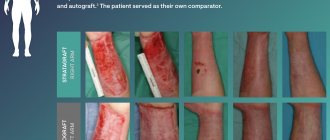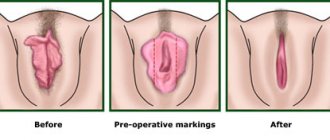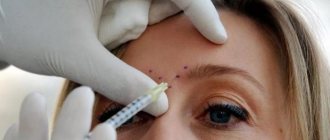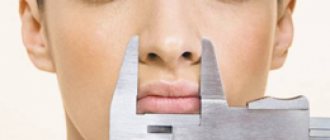Monday, December 3, 2018
Deformation of the male genital organ is a rare disease, but it brings physical and psychological discomfort to the patient. The pathology occurs in representatives of the reproductive age group of 30-60 years with a frequency of 3-8%. Persons with signs of severe deformation and erectile dysfunction consult a doctor.
The pathological condition in which there is a curvature of the penis is called Peyronie's disease. The first to describe the disease was the French surgeon Francois Peyronie. Fibroplastic induration of the penis develops as a result of the replacement of the structures of the tunica albuginea of the penis with dense connective tissue, which leads to severe deformation of the organ, problems with painful erection and a man’s sexual life. Benign seals are located on the back of the organ, the urethra and on the sides of the penis.
Types of pathology
According to the development of the disease, they are distinguished.
- Acute type of disease. There is an active blood supply to the penile plaques, which makes surgical treatment impossible.
- Chronic appearance. Impaired blood supply and blood microcirculation in the plaque. The process leads to the formation of a dense scar.
There are three categories based on the degree of deformation:
- I change in curvature is less than 30 degrees;
- II curvature is 30-60 degrees;
- III violation of 60 degrees or more.
The appearance of severe pain during sexual intercourse, a change in the shape of the organ should alert the patient and force him to consult an andrologist or urologist. The degree of neglect of the process affects the choice of treatment tactics and management of the patient. The risk of developing the disease increases in young people who engage in active and extreme sports.
What examination can be offered to me?
The examination will consist of a detailed consultation with a doctor, a thorough examination and a possible ultrasound examination of the penis against the background of an erection. Sometimes the doctor may ask you to provide a photograph of the penis during an erection to better understand the extent of its curvature. Only after a detailed conversation with the patient, a thorough examination and examination, the doctor can decide on the choice of surgical technique that will be optimal for this particular case.
Causes
The pathogenesis of the disease is not fully understood. There are several theories that provoke penile curvature. It can be a consequence of two factors: congenital and acquired.
Congenital forms:
- heredity, the presence of gene abnormalities that are responsible for the synthesis of connective tissue protein collagen. Morphologically, the formation of connective tissue cords is noted in the cavernous bodies;
- abnormalities of organ development, short urethra, changes in the structure of the vascular network of the organ, hypoplasia of the tunica albuginea. The irregular shape of the penis is noticeable when it is filled with blood (erect state).
Purchased forms:
- injuries, bruises, organ fractures, which lead to the formation of hematomas and the development of inflammation. Without adequate therapeutic measures, the regeneration process leads to the formation of fibrous tissue of the cavernous bodies. Scar changes can thicken and cause deformation of the penis;
- autoimmune diseases. Cells of the immune system are able to attack their own tissues and cause damage, plaques and scars;
- drug therapy for diseases of the cardiovascular system, the use of beta blockers;
- drug treatment of impotence. Repeated administration of drugs injures the protein membrane of the organ and causes scarring;
- the use of various methods of stretching the penis, which provokes disruption of blood flow;
- vascular atherosclerosis, diabetes mellitus;
- connective tissue diseases: Dupuytren's contracture, Paget's disease, tympanosclerosis;
- hypo-, tocopherol vitamin deficiency, deficiency of microelements: calcium, magnesium;
- hypersecretion of the hormone serotonin;
- age-related changes in tissue elasticity.
Symptoms
Congenital curvature of the penis is rarely diagnosed. The deformity develops as a result of genetic damage during pregnancy. Injuries to the penis in childhood affect the processes of its growth during the active synthesis of hormones. Healthy tissues continue their development, which provokes the development of downward curvature of the organ.
The main symptom of the disease is pain during sexual intercourse. Morphologically, this process is manifested by differences in the anatomical areas of the organ. During an erection, the area with lost elasticity and compaction is stretched with great tension, causing pain. Peyronie's pathology provokes the development of acquired curvature of the penis.
The disease is diagnosed in men starting at the age of 40; cases occur in young people after 30 as a result of an overly active sexual life.
In areas of the organ with impaired tissue nutrition, salt crystals are deposited, around which an inflammatory process develops and tissue tightening and scarring occurs. As a result, the functioning of the reproductive system is disrupted, ejaculate is retained, and erectile dysfunction develops. Treatment of penile curvature must begin in the early stages of the formation of the pathology.
If the disease does not cause sexual discomfort or pain during erection, surgery will not be necessary.
Situations in which you should contact an andrologist-urologist.
- Injury to the organ causes contraction of the urethra and disruption of the outflow of urine. The patient feels severe discomfort, the frequency of the urge to go to the toilet increases, irritation of the bladder, and the development of inflammation are noted. Correction of this condition must take place urgently in order to preserve the functions of the urinary system.
- Circulatory disorders. Insufficient oxygen saturation of tissues causes atrophic changes. Prolonged oxygen starvation will lead to organ necrosis.
- Fibrous scars. Causes deformation of the penis with a deviation of 20 degrees. Tissue damage leads to malignant degeneration and therefore requires immediate treatment.
- Erectile disfunction. Correction of the curvature of the penis is needed if the pathology disrupts a man’s sexual activity and interferes with ejaculation.
Therapeutic measures restore the biological functions of the organ and help prevent irreversible changes in the shape and size of the organ.
Classification of the disease
Fibroplastic induration of the penis occurs in acute and chronic forms.
Inflammatory phase:
- period of plaque formation.
Acute (active) phase:
- develops from 6 to 18 months;
- there is pain during sexual intercourse, slight deformation of the penis, dense plaques begin to form;
- conservative treatment is prescribed;
- in the absence of a therapeutic effect, surgical intervention is used.
Chronic form:
- plaque growth stops;
- symptoms of erectile dysfunction worsen;
- The maximum permissible curvature is noted.
If the pathology does not complicate the patient’s life, therapy can be avoided. Connective tissue plaques do not degenerate into a malignant tumor.
Indications for surgery
As the pathology progresses, curvature from the central axis to the left or right, upward or downward is noted. The need for surgical treatment arises mainly in the later stages of Peyronie's disease.
The main indications for penile correction surgery are:
- discomfort and pain during erection, coitus, ejaculation;
- the occurrence of erectile dysfunction;
- severe forms of deformation in which sexual intercourse becomes impossible;
- personal dissatisfaction of the patient with the fact of curvature.
Diagnostics
To determine the exact cause of the curvature of the penis, the patient goes to a specialized clinic. The doctor conducts a visual examination, which allows you to determine the presence of plaques, their location and size, and an assessment of erectile function. To confirm the diagnosis, methods are used:
- Ultrasound diagnostics. The vessels of the genital organ, patency, and the presence of foci of thrombosis are examined. The size of the urethral canal is assessed.
- Radiography. A mandatory study that helps determine the presence of plaques containing calcium salts. In the absence of calcifications, the method may be uninformative.
- CT scan. Identifying problems with venous blood flow that may occur with penile deformation.
- Laboratory research.
- An advisory opinion from an andrologist based on the collected history and condition of the patient, who will decide how to correct and cure the curvature of the penis.
Is it possible to have sex after correction of the deformity?
In the postoperative period, to “consolidate” the result, I recommend that patients use a vacuum pump if necessary, and to improve blood flow in the penis, I prescribe special medications. Abstinence from sex is usually necessary for a month after surgery (and careful use of the organ in the future!) to avoid relapse.
Of course, I can correct deformities that arise again and again, but is this really necessary? Isn't it better to take care of something that has already been corrected once?
Of course, each procedure is prescribed individually, and first of all it is necessary to consult with a specialist.
THERE ARE CONTRAINDICATIONS. CONSULT WITH AN EXPERT
Treatment
In modern practice, urologists use several treatment regimens for penile curvature.
Conservative treatment:
- hormonal drugs: cortisone, hydrocortisone. Their action is aimed at inhibiting collagen synthesis and resorption of fibrous plaques;
- enzymatic preparations. Enzymes reduce the concentration of connective tissue protein and the formation gradually resolves, the deformation is removed;
- using an extender to correct and change the shape of the penis. Used in the early stages of the disease;
- physiotherapeutic methods, ultrasound therapy, laser treatment. Used to treat Peyronie's pathology in children. Under the influence of ultrasound, stimulation occurs, then resorption of the seals occurs;
- administration of anti-inflammatory drugs;
- taking vitamins A and E.
Drug therapy is suitable in the initial stages of the disease and is effective in the classic form of Peyronie's disease.
Surgical method.
The operation is often used in case of a pronounced defect to correct the curvature of the penis. After the intervention, organ functions are restored within several months.
Types of surgical interventions:
- excision or removal of fibrous plaques;
- increase in the size of the protein shell;
- penile prosthesis is used for severe erectile dysfunction.
The quality of treatment will depend on the stage and severity of the pathological process. Surgical intervention is carried out within a year from the appearance of the first signs and during the active stage of the process.
How is penile curvature corrected?
Corporoplasty for Peyronie's disease is aimed at lengthening the tunica albuginea, which has shortened due to scarring. During surgery, the fibrous plaque is dissected, resulting in a defect in the tunica albuginea that must be replaced with some alternative tissue. A patch is actually applied to the resulting gap. This may be a venous wall, tissue from the inside of the cheek, cadaveric tissue, or artificial material used in surgery.
Corporoplasty is used in cases of severe curvature, when alternative techniques do not help, for example, corrugation of the tunica albuginea on the side not damaged by plaques and scars.
conclusions
Fibroplastic induration or Peyronie's pathology is a pathological process in which foci of tissue fibrosis form in certain areas of the organ. The deformity causes pain during sexual intercourse, causes erectile dysfunction, difficulty in ejaculation, and psychological problems due to disruption of the quality of a man’s sexual life. Modern medicine has described congenital and acquired forms of pathology. The main cause of the acquired disease is frequent injuries to the penis and impaired blood supply.
Modern clinics use conservative, microinvasive and surgical treatment methods. The pathology of penile curvature can be successfully treated in the initial stages of development. An individual approach and selection of the optimal treatment method are applied to each patient.
| Code | Name | Price |
| 03.66 | Initial appointment with an andrologist | 2,000 rub. |
| 03.67 | Repeated appointment with the andrologist | 1,000 rub. |
| 03.68 | Initial appointment with an andrologist (candidate of medical sciences) | 2,500 rub. |
| 03.69 | Repeated appointment with an andrologist (candidate of medical sciences) | 1,500 rub. |
| 03.70 | Initial appointment with an andrologist (MD) | 3,000 rub. |
| 03.71 | Repeated appointment with an andrologist (MD) | 1,500 rub. |
| All prices of the andrology department | ||










